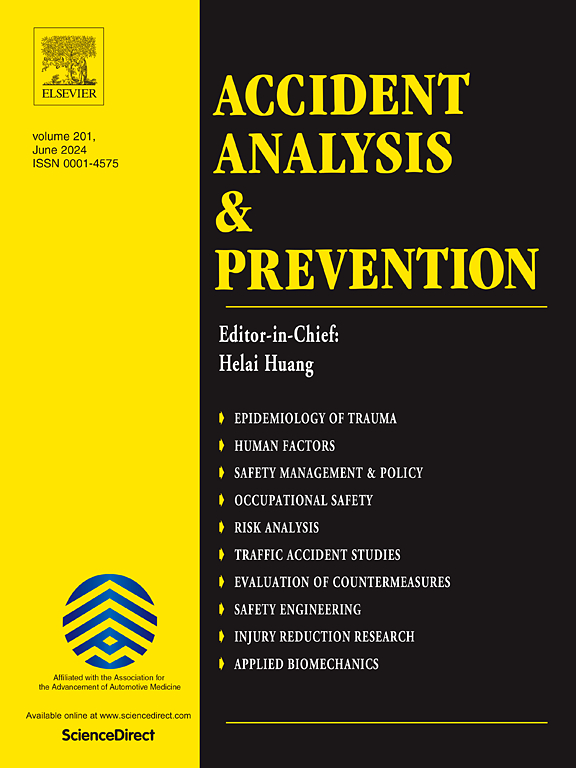车辆是否可以使用人类模糊语义逻辑来分析驾驶风险?数据知识驱动的新视角
IF 6.2
1区 工程技术
Q1 ERGONOMICS
引用次数: 0
摘要
准确的风险识别对于确保主车(hov)在与邻车(nev)共享的环境中安全运行至关重要。传统的风险识别机制通常依赖于大量精确的数值数据,在数据不完善、信息模糊的情况下,难以全面准确地识别交通事故风险。然而,人类驾驶员依赖于知识驱动的主观评估,使用模糊描述符(如距离和速度语义)来评估驾驶风险。这些见解为解决精确数据驱动方法的局限性提供了重要价值。本研究提出一种新的交通事故风险分析框架,称为令牌树生成与解析(TTGP)。它将来自人类驾驶员的知识驱动的见解与数据驱动的方法相结合。TTGP包括令牌树生成模块(模块1)和令牌树解析模块(模块2)。在模块1中,我们运用token-tree-of-thought方法,将自然语言交通规则和车辆的交通行为及属性参数转化为基于语义规则的token树。该模块模拟了交通场景中人类模糊语义的生成。在模块2中,我们集成了三个编码器和解码器来提取交通崩溃风险语义特征,并从数字化令牌树中识别交通崩溃风险级别。在高速公路和城市高速公路交错处的试验表明,TTGP可以利用不精确的数据准确地分析风险。TTGP的性能优于Tree、Naïve贝叶斯、RUSBoost和Efficient Logistic Regression模型等传统方法。本研究显著提高了风险评估的灵活性、通用性和可靠性。它填补了hov在风险分析中如何处理模糊信息的空白。本文章由计算机程序翻译,如有差异,请以英文原文为准。
Could vehicles analyze driving risks using human fuzzy semantic logic? A data-knowledge-driven new perspective
Accurate risk identification is crucial for ensuring the safe operation of Host vehicles (HoVs) in environments shared with Neighboring vehicles (NeVs). Traditional risk identification mechanisms typically rely on large amounts of precise numerical data, making it difficult to comprehensively and accurately identify traffic crash risks under conditions of imperfect data associated with fuzzy information. However, human drivers rely on knowledge-driven, subjective assessments using fuzzy descriptors like distance and speed semantics to evaluate driving risk. These insights provide significant value for addressing the limitations of precise data-driven methods. This study proposes a novel traffic crash risk analysis framework called Token Tree Generation and Parsing (TTGP). It integrates knowledge-driven insights from human drivers with data-driven methods. TTGP includes the Token Tree Generation Module (Module 1) and the Token Tree Parsing Module (Module 2). In Module 1, we apply the token-tree-of-thoughts method to transform natural language traffic regulations and vehicles’ traffic behaviors and attribute parameters into token tree based on semantic rules. This module simulates the generation of human fuzzy semantics in traffic scenarios. In Module 2, we integrate three encoders and decoders to extract traffic crash risk semantic features and identify traffic crash risk level from the digitized token tree. Experiments in the highway and urban expressway interweaving areas demonstrate that TTGP can accurately analyze risk using imprecise data. The TTGP performs better than traditional methods such as Tree, Naïve Bayes, RUSBoost and Efficient Logistic Regression models. This study significantly enhances the flexibility, generalization, and reliability of risk assessment. It bridges the gap in how HoVs handle fuzzy information in risk analysis.
求助全文
通过发布文献求助,成功后即可免费获取论文全文。
去求助
来源期刊

Accident; analysis and prevention
Multiple-
CiteScore
11.90
自引率
16.90%
发文量
264
审稿时长
48 days
期刊介绍:
Accident Analysis & Prevention provides wide coverage of the general areas relating to accidental injury and damage, including the pre-injury and immediate post-injury phases. Published papers deal with medical, legal, economic, educational, behavioral, theoretical or empirical aspects of transportation accidents, as well as with accidents at other sites. Selected topics within the scope of the Journal may include: studies of human, environmental and vehicular factors influencing the occurrence, type and severity of accidents and injury; the design, implementation and evaluation of countermeasures; biomechanics of impact and human tolerance limits to injury; modelling and statistical analysis of accident data; policy, planning and decision-making in safety.
 求助内容:
求助内容: 应助结果提醒方式:
应助结果提醒方式:


